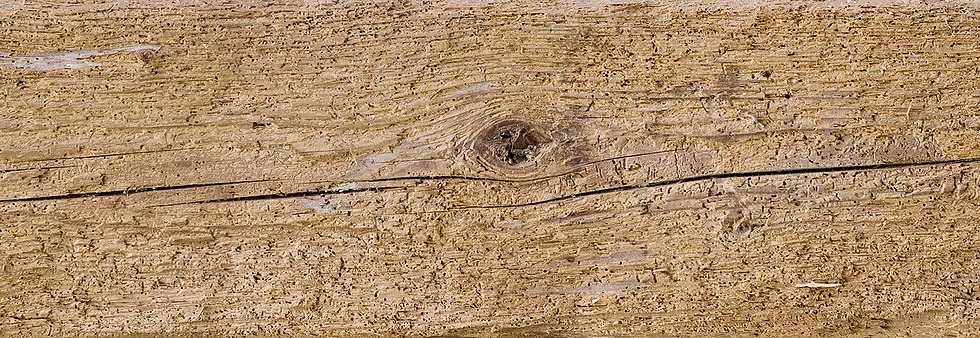
For the handling of damp and timber problems, a one-size-fits-all solution can’t be applied. As specialists, we conduct a survey in order to determine the most effective course of action to solve your unique issue. We’ve worked extensively in all manner of homes to solve an endless list of problems, as demonstrated by our case studies page.
What is a Woodworm?
Woodworm is a loose term that references the larvae of multiple different species of wood-boring insects. Usually, the insect that causes woodworm is the common furniture beetle (anobium punctatum), which is responsible for 75% of all timber damage in the UK. The beetle lays its eggs within the wood. When the larvae emerge, they consume the internal areas of timber for up four years until they are ready to pupate and change into adults.
From a preventative perspective, ensuring the wood in your home remains dry is crucial to avoid woodworm-related issues, as larvae prefer wood with a moisture content of 15-30%. Use your central heating and ventilation systems to keep the wood in your home from getting too damp. Ensuring good sub-floor ventilation and maintaining adequate, unblocked airbricks that allow the sub-floor timbers to remain dry is also essential. If left unchecked, woodworm can lead to structural weakness, so any woodworm problems must be dealt with sooner rather than later.
Fortunately, identification and treatment of woodworm are relatively simple as long as there is an accurate understanding of the scale of the problem and what species of beetle is causing the issue.
Book a Damp Survey for Bespoke Woodworm Treatment
FAQs
How does woodworm start?
Woodworm is caused by excessive moisture in structural timber. This creates an environment in which female beetles can lay their eggs. Once hatched, the woodworm will burrow through the timber, leaving behind channels (galleries) as it does so.
What does woodworm look like?
Woodworm is usually relatively easy to notice and identify. The most apparent symptoms of woodworm are flight holes, usually 1-2mm in diameter, that adult beetles create as they leave the wood. Often, these holes have a fine, sawdust-like substance called frass around them – another remnant of the adult beetle’s departure from the wood. By identifying the presence of these holes and frass, you can tell if the woodworm is active.
Some less common signs of woodworm include weak or crumbling timber or visible tunnels where the larvae have travelled through the wood. If you notice any of these signs, get a fully qualified (CSRT or CSTDB trained) expert, like Garratt’s Damp & Timber, to investigate the issue further and identify the most appropriate treatment.
Can woodworm spread?
Woodworm can spread quickly and easily around your home via the timber that runs throughout your property. This is why woodworm should be treated as a matter of urgency.
How do you treat woodworm?
If you have identified a cause for concern, it’s time to investigate how to treat woodworm. The most crucial point to remember is that while most woodworm problems result from the common furniture beetle, this doesn’t mean they all are. Unfortunately, the treatments that work effectively on the common furniture beetle don’t always work on the other species. Furthermore, other beetle types that infest and attack can be much more destructive if left unchecked. This is why you need to conduct a professional survey as soon as possible, as the surveyor will generally be able to identify the particular species of beetle and, in turn, select the most suitable treatment method.
In the case of the common furniture beetle, treating woodworm is reasonably simple. It involves using a chemical spray, which can be applied thoroughly to some areas with a brush where necessary. The insecticide seeps into the upper few millimetres of wood to eradicate the adult beetle as it exits the timber, thus disrupting the breeding cycle and protecting the area from further infestation. After being left for an hour, this woodworm treatment is complete, and client re-entry is safe, making it one of the least intrusive options.
For more invasive species, such as the death watch beetle (xestobium rufovillosum), a gel treatment may be more suitable. The gel can be injected into the wood and applied to the timber’s surface to deal with the woodworm infestation effectively.
.
How much does woodworm treatment cost?
The cost of woodworm treatment services varies greatly depending on the infestation’s scale, the species being dealt with, and the treatment required.
Garratt’s Damp & Timber offers home surveys where we will inspect the property, diagnose any prevalent damp issues, and offer a solution to eradicate the problem. Our team of professionals will ensure that you are kept fully informed about the costs involved and how long any treatment and/or repair work is expected to take.
Woodworm Specialists in London
With over 20 years of experience 7dealing with damp and woodworm issues, the specialist team here at Garratt’s Damp & Timber is perfectly equipped to survey and treat your woodworm problems. We always recommend booking an inspection so that one of our professional surveyors can accurately identify the extent of your woodworm infestation, ensuring a prompt and appropriate treatment that works the first time.
We provide woodworm treatment in the following areas:
- East London
- Southwest London
- North London
- West London
- North Home Counties
We offer a 30-year guarantee on all our woodworm treatments to ensure that each and every one of our customers is fully satisfied with the service we provide. We pride ourselves on honest, client-centric advice, so if you would like a survey, please don’t hesitate to give us a call at 0208 535 7536 or contact us online.







